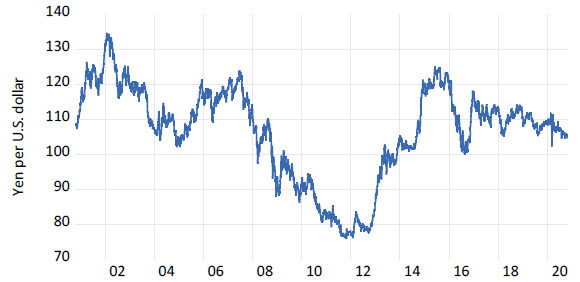| Author Name | Willem THORBECKE (Senior Fellow, RIETI) / Nimesh SALIKE (Xi'an Jiaotong-Liverpool University, Suzhou) / CHEN Chen (Xi'an Jiaotong-Liverpool University, Suzhou) |
|---|---|
| Download / Links |
This Non Technical Summary does not constitute part of the above-captioned Discussion Paper but has been prepared for the purpose of providing a bold outline of the paper, based on findings from the analysis for the paper and focusing primarily on their implications for policy. For details of the analysis, read the captioned Discussion Paper. Views expressed in this Non Technical Summary are solely those of the individual author(s), and do not necessarily represent the views of the Research Institute of Economy, Trade and Industry (RIETI).
As Figure 1 shows, the Japanese yen has been volatile since 2000. Exchange rate changes impact trade prices, firm profitability, and trade flows. Export and import volatility in turn amplifies business cycle fluctuations. This paper uses the Japanese chemical industry to investigate whether certain types of goods are less exposed to exchange rate changes. The Japanese chemical industry is the country's second largest manufacturing industry, with annual shipments exceeding USD 400 billion (Note 1). Chemical firms provide super engineering plastics and elastomers for automobiles, fluorinated polyimide, photoresists, and etching gas for electronic parts and components, soda ash for glass, and other vital inputs to downstream industries.
We first estimate exchange rate exposures for 51 Japanese chemical firms. We find that Japanese chemical firms linked to industries such as automobiles and electronic parts and components (ep&c) are harmed the most when the yen appreciates. Ito, Koibuchi, Sato, and Shimizu (2018) reported that the automobile market in places like the U.S. is so competitive that Japanese automakers must invoice in the importing country's currency. Katz (2012) noted that integrated circuits and similar products have become commoditized and that Japanese producers must compete in this sector based on price. The automobile and ep&c sectors are thus exposed to yen appreciations. On the other hand, Japanese chemical firms linked with the pharmaceutical and biotechnology sectors are not harmed by appreciations. Sauré (2015) observed that prescription drugs often have low price elasticities because they are essential and covered by health insurance plans. The pharmaceutical and biotechnology sectors should thus be less exposed to appreciations.
We then investigate the relationship between product sophistication and trade elasticities for the Japanese chemical industry. We employ data on 93 different categories of chemical exports from Japan. We follow Arbatli and Hong (2016) in employing Hidalgo and Hausmann's (2009) product complexity index (PCI) to measure sophistication. We find a strong relationship between more complex products and lower price elasticities.
The findings reported in this paper have implications for firms and policy makers. Upstream firms should diversify the downstream industries they supply to. If they focus on a single industry like electronic parts and components, then exchange rate appreciations such as occurred with the yen between 2007 and 2012 can devastate downstream firms and their upstream suppliers. Firms should also invest in research and development (R&D), especially during profitable periods, so that they can innovate and produce differentiated products. Governments should encourage R&D by easing firms' tax burdens. They should also nurture creativity by providing future engineers and scientists not just technical training but also a broad education that includes literature, history, and philosophy (Sawa, 2013). Finally, firms and governments should encourage cross cultural collaboration to develop cutting edge ideas and foster discoveries (Berliant and Fujita, 2012).

- Footnote(s)
-
- ^ These data come from the Japanese Chemical Industry Association website. The URL is https://www.nikkakyo.org/
- Reference(s)
-
- Arbatli, E., & Hong, G. H. (2016). Singapore's export elasticities: A disaggregated look into the role of global value chains and economic complexity. (Working Paper No.16–52). Washington, DC: International Monetary Fund.
- Berliant, M., Fujita, M. (2012). Culture and diversity in knowledge creation. Regional Science and Urban Economics, 42, 648–662.
- Hidalgo, C. A., & Hausmann, R. (2009). The building blocks of economic complexity. Proceedings of the National Academy of Sciences, 106, 10570–10575.
- Ito, T., Koibuchi, S., Sato, K., Shimizu, J. (2018). Managing currency risk. Cheltenham, UK: Edward Elgar Publishing.
- Katz, R. (2012). Elpida: tip of the iceberg. The Oriental Economist 80, 1-3.
- Sauré, P. (2015) The resilient trade surplus, the pharmaceutical sector, and exchange rate assessments in Switzerland. Peterson Institute for International Economics Working Paper No.15-11, Washington DC.
- Sawa, T. (2013). Lack of liberal arts education is sapping Japan's creativity. The Japan Times, 16 September.

